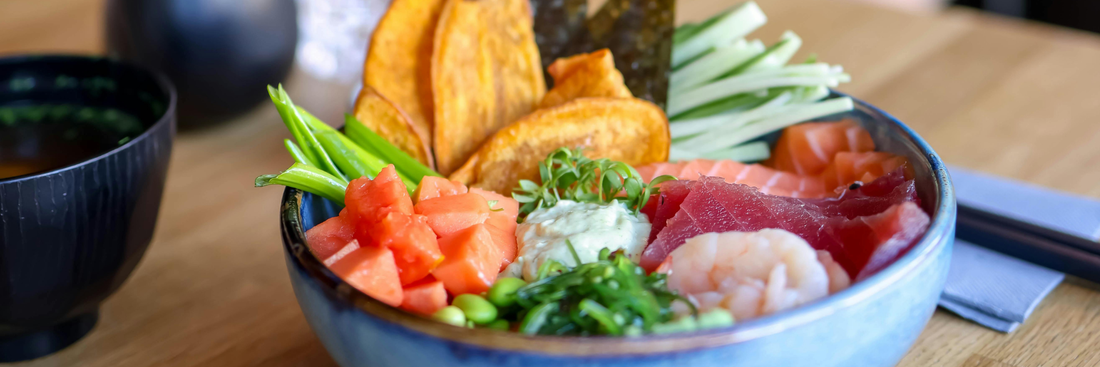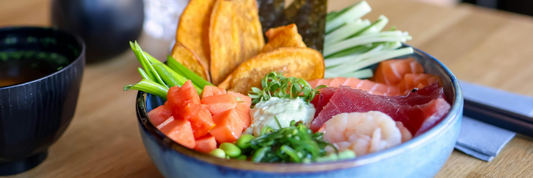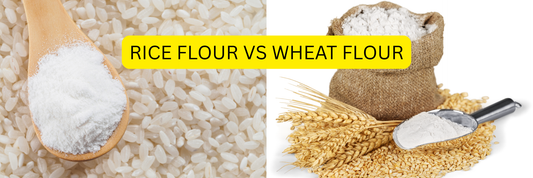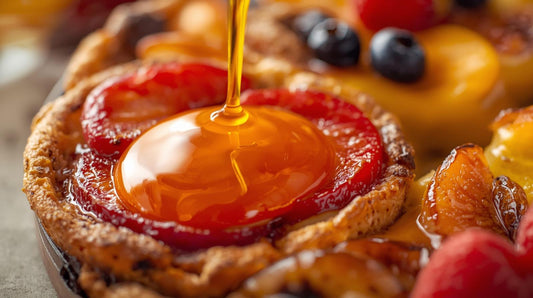If you’re searching for a flavour-packed, nourishing, and easy-to-make meal, the salmon bowl ticks all the boxes. In this comprehensive guide we go deep into what a standout salmon bowl is, why the salmon bowl trend is strong, how to build one step-by-step, the best salmon bowl recipe variations, meal-prep tips, nutrition, and much more. Ready to dive into the world of salmon bowls?
- Fusion or Classic Sushi Style? Decoding the Sushi Style Trending for Your Restaurant
- Lemon Butter Sauce Salmon – Restaurant-Quality Recipe in 20 Minutes
- Acai Bowl vs Smoothie Bowl: What’s the Difference and Which Is Better?
What is a Salmon Bowl?

A salmon bowl is typically a balanced meal served in a bowl, centred around salmon (grilled, baked, seared or even raw in some versions) atop a base (grain like rice/quinoa or greens), combined with vegetables, healthy fats and a sauce or dressing. The salmon bowl often draws inspiration from poke bowls, deconstructed sushi bowls and Asian-flavoured rice bowls.
What makes one a “salmon bowl”? The salmon is the star protein; the base gives substance; the veggies/toppings supply crunch, colour and nutrition; the sauce brings flavour unity. For example, one version of the salmon bowl features seared garlic-ginger salmon on brown rice with avocado, cucumber and nori.
When you build a salmon bowl well, you get something satisfying, visually appealing and nutritionally rich.
Why the Salmon Bowl Trend?
There are several reasons why the salmon bowl has become such a favourite:
- Health appeal: Salmon is rich in omega-3 fatty acids, lean protein and essential vitamins making the salmon bowl a go-to for nutritious meals.
- Customisable & fast: The salmon bowl can be built in under 20-30 minutes, making it ideal for weeknight dinners or meal-prep. For many recipes, the cooking time is extremely short.
- Visual & social friendly: Bowls stack colourful ingredients for an eye-catching appearance perfect for food blogs, Instagram and social media.
- Adaptable base: You can swap the grain (rice, quinoa, cauliflower rice), change the veggies, the sauce, the cooking method of the salmon. This flexibility makes the salmon bowl accessible for different diets (low-carb, gluten-free, vegan modifications).
- Simplified cooking: Many recipes call for marinating salmon, cooking it quickly, and assembling in a bowl straightforward.
Because of all this, the salmon bowl isn’t just a “recipe”, it’s a meal concept that can be tailored, scaled, and repeated.
Components of a Great Salmon Bowl

When you construct a salmon bowl, you want to think of it in terms of components. These critical elements ensure the salmon bowl is flavourful, balanced and satisfying:
The Salmon
Choose fresh salmon fillets (skin-on or skinless as you prefer). The salmon is the star of your salmon bowl. Many recipes use cubed salmon (for quicker cooking) or whole fillets. For example, one recipe uses 1 inch cubes of salmon, seasoned and quickly seared.
Important: cook the salmon just right (see cooking section later). Over-cooking can make it dry.
The Grain or Base
This provides the “body” of the bowl. Common bases include: white rice (jasmine or sushi), brown rice, quinoa, cauliflower rice (for low-carb) or even greens. For example, some salmon bowl recipes explicitly use quinoa or white rice.
Choosing your base depends on your dietary goal (e.g., lower carb) and texture preference.
Vegetables & Healthy Fats
These add texture, colour and health-benefits. Typical ingredients: avocado (healthy fat), cucumber (crisp freshness), edamame (protein + fiber), carrots (color), pickled onions (tang), seaweed/nori (umami) etc. One blog mentions avocado, edamame, cucumber and mango topping their salmon bowl.
Including abundant vegetables elevates the nutrition of your salmon bowl substantially.
Sauce or Dressing
A good sauce ties everything together: you might have spicy mayo, sriracha mayo, teriyaki-style glaze, soy-ginger marinade or sesame oil/soy combo. One recipe: marinade salmon in soy + garlic + ginger + honey + sriracha.
Be mindful of sauce portion and flavour intensity, you want it to complement, not overpower, the salmon and veggies.
Toppings & Garnishes
These give a finishing touch sesame seeds, green onions, furikake, pickled cucumbers, mango, seaweed snacks etc. These toppings add visual appeal, flavour contrast and texture.
In short: a great salmon bowl = Quality salmon + Well-chosen base + Vibrant toppings + Flavourful sauce.
How to Make a Basic Salmon Bowl (Step-by-Step)
Here’s a fool-proof method to build your salmon bowl. You can adapt timings/ingredients as desired.
Step 1 – Prep the salmon
- Choose a salmon fillet (skin on/off) or cut into cubes (1 inch) for quicker cooking.
- Season or marinate. Example marinade: soy sauce, garlic, ginger, honey and sriracha.
- Let it sit for at least 15-20 minutes (or up to overnight) to absorb flavour.
Step 2 – Cook the salmon
- Pan-searing cubes: heat a skillet, add a little oil, cook ~2-3 minutes each side until internal temperature ~125-130 °F / ~52-55 °C for medium (varies). For fillets, maybe 4-6 minutes each side depending on thickness.
- Baking/roasting: e.g., bake at ~400 °F/200 °C for about 7-9 minutes.
- Alternatively, air-frying or grilling works: again key is not to overcook, aim for moist, slightly crisp exterior.
Step 3 – Prepare the base
- Cook your rice/quinoa/alternative according to instructions. Let it rest.
- If using cauliflower rice/greens, prep accordingly (steam or sauté light if needed).
- Arrange a generous portion in the bottom of your bowl.
Step 4 – Prep vegetables & toppings
- Slice cucumber, shred carrots, prepare edamame (cook if frozen), slice avocado.
- Optional: quick-pickle onions or cucumber for tang.
- Prepare any extra toppings: sesame seeds, green onions, nori strips, mango cubes etc.
Step 5 – Assemble the bowl
- Add the base to a bowl.
- Top with the cooked salmon (fillet or cubes).
- Arrange veggies/fats around the salmon (avocado, cucumber, edamame etc).
- Drizzle the sauce or dressing evenly.
- Sprinkle toppings & garnishes.
Step 6 – Serve & enjoy
- Serve while salmon is hot (or allow to cool slightly if you prefer chilled).
- Eat immediately for best texture; if leftover, refrigerate separately and assemble just before eating for freshness.
Pro tip: If you’re meal-prepping, cook components ahead, but keep sauce and avocado fresh/un-dressed until serving.

Salmon Bowl Recipe Variations
To keep things interesting, here are some delicious variations you can try:
Spicy Salmon Bowl
Cubed salmon marinated with coconut aminos/soy + sriracha + sesame oil, served with cucumber, edamame and spicy mayo.
This version prioritises heat + crisp veggies for contrast.
Honey-Sriracha Salmon Bowl
Marinate salmon in soy sauce, honey and sriracha for a sweet-spicy finish. Serve with rice, avocado, cucumber and sriracha mayo.
Great for those who like sweetness plus kick.
TikTok-Inspired Salmon Rice Bowl
Inspired by the viral version by Emily Mariko: leftover salmon, white rice, soy sauce, kewpie mayo, sriracha, avocado and seaweed. While technically more of a “leftover salmon bowl”, same structure applies.
Asian Salmon Rice Bowl
Marinated salmon, quick-pickled cucumber, edamame, carrots, avocado, furikake and spicy mayo atop sushi rice or brown rice.
Low-Carb / Grain-Free Salmon Bowl
Swap rice for cauliflower-rice or fresh greens; use grilled salmon and load up on veggies, keep sauce light. One recipe mentions using cauliflower rice as low-carb base.
This works well for keto or reduced-carb plans.
Nutrition & Health Benefits of the Salmon Bowl
The salmon bowl isn’t just visually appealing, it offers substantial nutrition and health benefits when built thoughtfully.
- Protein & healthy fats
Salmon is an excellent source of high-quality protein and rich in omega-3 fatty acids (EPA, DHA) which support heart and brain health, inflammation reduction, and more. Many articles highlight the health boost from salmon.
Including avocado and edamame further boosts healthy fats and plant protein. - Fibre, vitamins & minerals
Including vegetables (avocado, cucumber, edamame, carrots) adds fibre, vitamins (A, C, K), potassium and antioxidants.
The base (rice/quinoa) contributes complex carbs and B-vitamins (if whole grain).
Sesame seeds, nori and green onions enhance micronutrient diversity. - Balanced meal
A properly constructed salmon bowl gives a good macro balance: protein (salmon), carbs (rice/quinoa), healthy fats (salmon + avocado), fiber/veg (veggies). It supports satiety and stable energy. One recipe calls it “balanced meal packed with carbs, veggies, protein & healthy fats from salmon and avocado.” - Flexibility for dietary needs
You can adapt the salmon bowl for gluten-free (use tamari instead of soy sauce), low-carb/gluten-free (swap cauliflower rice), dairy-free (no dairy sauce) etc. Good versatility. - Meal-prep friendly
Because you can cook the salmon and base ahead, chop vegetables ahead, this becomes a practical meal for busy schedules. Many authors note the ease of prepping salmon bowls ahead.
Potential considerations
- Portion control: If you use large amounts of rice or heavy sauces, calories can add up.
- Salmon sourcing: Quality and freshness matter.
- Sauce sugars/sodium: Some marinades/sauces use sugar/honey/soy – moderate if watching sugar/salt.
Overall, the salmon bowl is a smart way to get a nutritious, flavourful meal with built-in flexibility.
Best Cooking Methods for Salmon in Your Salmon Bowl
The method you use to cook salmon affects texture, flavour and how it sits in the bowl. Here are some of the best methods:
Pan-searing
One of the fastest methods, especially for cubed salmon. Pre-heat skillet, add oil, cook cubes ~2-3 mins per side or until just cooked through. Works well for texture contrast (slightly crisp exterior, moist interior).
Example: Some chefs recommend ~2-3 mins each side for cubed salmon in bowls. Baking/Roasting
Use if you prefer hands-off cooking. Preheat oven ~400 °F / 200 °C, place marinated salmon (fillet or cubes) on baking sheet, bake ~7-9 minutes (for cubes) until cooked through. Example given in recipe.
Advantage: you can cook salmon and veggies or base simultaneously if using sheet-pan.
Air-Frying
Great for crisping without deep frying. Example: one site did air-fry salmon fillets 5-7 minutes at 400 °F for salmon bowls. Works well for meal-prep portions.
Grilling
Adds smoky flavour if you have an outdoor or indoor grill. Good for thicker fillets; watch timing carefully to avoid over-cooking.
Advantage: adds a char flavour that pairs nicely with bowl toppings like mango, cucumber or spicy sauce.
Raw / Poke-Style
If using sashimi-grade salmon and comfortable with raw fish, you can do a poke-style salmon bowl. While this veers slightly away from “cooked salmon bowl”, the structure is similar. Ensure safe sourcing of salmon. One article on poke bowls noted this form.
Tip: The internal temperature for cooked salmon is ~145 °F (63 °C) according to USDA guidelines but some chefs prefer ~125-130 °F for medium and moist texture. Many home recipes don’t use a thermometer but judge by flakiness.
Choosing the Best Salmon for Your Salmon Bowl
Since salmon is the star of your salmon bowl, choosing the right salmon is important.
- Freshness matters
Look for salmon with bright colour (pink to orange/red depending on species), flesh that’s firm and springs back, minimal smell (should smell like clean sea/river, not “fishy”) and no sliminess. - Wild-caught vs farmed
Wild-caught salmon often has a richer flavour and may have higher omega-3 content. Farmed salmon is usually more affordable and accessible. Either can work just choose good quality from trusted supplier. - Skin-on vs skinless
Skin-on can give you crispy skin if you like that texture. Skinless is easier for bowls (no need to remove skin at eating time). Choose based on your preference. - Fillet vs cubes / cut
If you plan to cube the salmon for faster cooking and more bowl-friendly bites, choose a thicker fillet you can cut into cubes. If you prefer whole fillet for presentation, choose a visually pleasing piece. - Sustainable sourcing
If you’re eco-conscious, check for sourcing labels (e.g., MSC certification, responsibly farmed, wild salmon from well-managed fisheries). - Frozen vs fresh
If fresh is unavailable, frozen is fine just thaw properly in the fridge and pat dry before cooking. One recipe mentions that for poke style raw versions you must freeze the salmon to kill parasites. For cooked salmon bowls, thaw and proceed. - Storage
If using fresh/sashimi grade, ensure proper storage (cold, away from other fish). If pre-marinated salmon sits in fridge too long, flavour and texture may degrade.
By choosing the right salmon, you’ll set your salmon bowl up for success.
Common Mistakes to Avoid When Building a Salmon Bowl
Even though salmon bowls are relatively simple, there are some common pitfalls. Here are things to watch out for:
- Overcooking the salmon: Leads to dry, brittle texture and weaker flavour.
- Undercooking the base or using a base that doesn’t pair well: If rice is soggy or under-cooked, the bowl suffers.
- Using too heavy or overpowering sauce: A sauce that is too heavy/sugary/salty can mask the salmon and veggies rather than complement them.
- Adding too many crunchy/strong textured toppings at once: While toppings are good, if you overload with many textures/flavours, you lose harmony.
- Not seasoning properly: A plain salmon cube + plain rice + plain veggies will be bland marinade, sauce, seasoning matter.
- Assembling too far in advance: If assembled and left too long, vegetables may wilt, rice may clump and textures degrade better to prep components and assemble when ready.
- Ignoring dietary needs: If someone is gluten-free, using soy sauce without tamari can be problematic. If low-carb, using white rice defeats the objective.
- Poor presentation: While not strictly “mistake,” the visual appeal of a salmon bowl adds to experience uneven arrangement, browning salmon, over-saucing can take away from appeal.
By avoiding these mistakes, your salmon bowl will deliver better flavour, texture, nutrition and aesthetics.
Salmon Bowl vs. Other Bowls: What’s the Difference?
With so many “bowl meals” out there (protein bowls, poke bowls, salad bowls), you might wonder how the salmon bowl stands out. Here’s a comparison:
- Compared with a standard protein bowl (chicken, beef): The salmon bowl emphasises healthy fats (omega-3) and flavourful fish base, which many other protein bowls don’t emphasise as much.
- Compared with a poke bowl: A poke bowl often uses raw fish (tuna or salmon), sushi rice or vinegared rice, and is very Japanese/Hawaiian in inspiration. A salmon bowl may use cooked salmon and more varied toppings (avocado, edamame, mango) with wider flavour palette.
- Compared with a salad bowl: Salad bowls often focus on greens, raw veggies, dressings and may lack a cooking step for protein. A salmon bowl uses a cooked salmon base plus a grain or other substantial base.
- Compared with a “grain bowl”: Grain bowls often revolve around quinoa, farro, roasted veggies etc. The salmon bowl integrates fish as main feature, making it a distinct subset of the “bowl meal” category.
In short: the salmon bowl combines the convenience of a bowl meal with the premium element of salmon + vibrant toppings. When someone says “salmon bowl,” you should expect salmon-centred, bowl-styled, well-balanced and flavour-packed.
Packaging & Presentation: From Kitchen to Take-Away
Since many cafés, meal-prep services and catering operations serve salmon bowls as retail or takeaway items, packaging and presentation matter. Here’s how to do it right:
- Choose eco-friendly bowls or boxes that keep components separate if needed (e.g., sauce compartment).
- Use clear-window or kraft packaging with branding to display colourful layers of your salmon bowl.
- Consider stacking or layering ingredients so the visual appeal remains when transported.
- For events, offer bowls in branded trays or multi-packs.
- Presentation tip: garnish with sesame seeds, microgreens or nori strips; keep sauce on the side or drizzle just before serving.
By pairing a delicious salmon bowl with premium packaging, you elevate your offering and create a memorable meal experience.
Frequently Asked Questions (FAQs) about Salmon Bowl

Are salmon bowls healthy?
Yes. A well-built salmon bowl provides lean protein (from salmon), healthy fats (from salmon + avocado), fibre and vitamins (from vegetables), and carbohydrates (from the rice or grain base). Many recipes highlight this benefit.
Of course, “healthy” depends on portion size, sauce amount, and balance of ingredients.
How do I know when salmon for a salmon bowl is cooked?
If you use a thermometer, aim for ~145 °F (63 °C) internal temperature, which is cited as safe by USDA. Many home chefs stop at ~125-130 °F for medium and moist texture. One recipe mentions reaching the salmon that “flakes easily with a fork”.
Visually: the flesh should turn opaque, flake easily, and not be translucent in the center.
What base should I use for a salmon bowl?
You can use white rice (jasmine, sushi rice), brown rice, quinoa, farro or even cauliflower rice for a low-carb version. Choose according to your dietary needs and texture preference.
Tip: sushi rice gives a sticky texture; quinoa gives nuttier flavour; cauliflower gives very light texture.
Can I meal-prep salmon bowls in advance?
Yes, one of the great advantages of the salmon bowl is that you can cook bulk salmon, cook the base ahead, chop vegetables, and assemble later. Just keep components separate until just before eating for best texture. If you assemble too early, vegetables may wilt and texture suffers.
What sauces go well in a salmon bowl?
Popular ones include spicy mayo (mayo + sriracha), teriyaki-style glaze (soy + honey + garlic + ginger), sesame oil + soy or coconut aminos. One recipe details a marinade of soy sauce, garlic, ginger, honey, sriracha.
Choose a sauce that complements your toppings and doesn’t overwhelm them.
Can I make a salmon bowl if I’m gluten-free or dairy-free?
Yes. Use tamari or coconut aminos instead of soy sauce (for gluten-free). Use mayonnaise without dairy (spicy mayo is common). Many salmon bowl recipes are naturally dairy-free. Example: one teriyaki salmon bowl recipe mentions how to make it gluten-free by substituting soy sauce with tamari.
What toppings work best in a salmon bowl?
Toppings that provide contrast in texture and flavour are great: avocado (creamy), cucumber (crisp), edamame (firm), mango (sweet), pickled onions (tang), carrots (bright), seaweed snacks (umami), sesame seeds (nutty). Example: one blog mentions avocado, edamame, cucumber, mango topping their salmon bowl.
Feel free to rotate toppings to keep things interesting.
How long does a salmon bowl last in the fridge?
If components are stored separately (salmon, rice, veggies, sauce), you can keep for 1-2 days safely (salmon cooked). For best quality, eat within that. If raw salmon (poke style) the guidelines differ. Avoid storing fully assembled with sauce and avocado for more than a few hours as textures degrade.
Can I substitute other fish in my salmon bowl?
Yes, but if you use a different fish you’re technically making a “fish bowl” rather than a true salmon bowl. The nutrition and flavour will differ depending on fish (e.g., tuna vs. salmon). But the “bowl” concept remains.
If you still want salmon-style flavours (soy, sesame, avocado) you can mimic the structure with other fish.
Is raw salmon okay for a salmon bowl?
Only if you’re using sashimi-grade salmon and comfortable with raw preparation (e.g., poke-style). Ensure safe sourcing and freezing protocols (for parasites). One article on poke mentions this requirement.
Conclusion
The salmon bowl is more than a trend, it’s a practical, delicious, nutrient-rich meal concept that you can tailor to your tastes, schedule and dietary goals. Whether you’re building a classic salmon rice bowl, exploring spicy or sweet variations, or adopting a low-carb version, the structure remains simple: quality salmon + well-chosen base + vibrant toppings + flavourful sauce = success.
With proper ingredient choices, smart cooking methods, and thoughtful assembly, the salmon bowl becomes a repeatable favourite.







